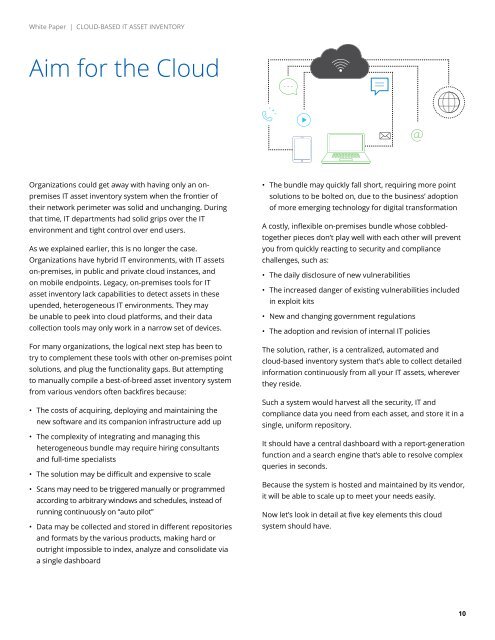Cloud-based IT Asset Inventory
You also want an ePaper? Increase the reach of your titles
YUMPU automatically turns print PDFs into web optimized ePapers that Google loves.
White Paper | CLOUD-BASED <strong>IT</strong> ASSET INVENTORY<br />
Aim for the <strong>Cloud</strong><br />
Organizations could get away with having only an onpremises<br />
<strong>IT</strong> asset inventory system when the frontier of<br />
their network perimeter was solid and unchanging. During<br />
that time, <strong>IT</strong> departments had solid grips over the <strong>IT</strong><br />
environment and tight control over end users.<br />
As we explained earlier, this is no longer the case.<br />
Organizations have hybrid <strong>IT</strong> environments, with <strong>IT</strong> assets<br />
on-premises, in public and private cloud instances, and<br />
on mobile endpoints. Legacy, on-premises tools for <strong>IT</strong><br />
asset inventory lack capabilities to detect assets in these<br />
upended, heterogeneous <strong>IT</strong> environments. They may<br />
be unable to peek into cloud platforms, and their data<br />
collection tools may only work in a narrow set of devices.<br />
For many organizations, the logical next step has been to<br />
try to complement these tools with other on-premises point<br />
solutions, and plug the functionality gaps. But attempting<br />
to manually compile a best-of-breed asset inventory system<br />
from various vendors often backfires because:<br />
• The costs of acquiring, deploying and maintaining the<br />
new software and its companion infrastructure add up<br />
• The complexity of integrating and managing this<br />
heterogeneous bundle may require hiring consultants<br />
and full-time specialists<br />
• The solution may be difficult and expensive to scale<br />
• Scans may need to be triggered manually or programmed<br />
according to arbitrary windows and schedules, instead of<br />
running continuously on “auto pilot”<br />
• Data may be collected and stored in different repositories<br />
and formats by the various products, making hard or<br />
outright impossible to index, analyze and consolidate via<br />
a single dashboard<br />
• The bundle may quickly fall short, requiring more point<br />
solutions to be bolted on, due to the business’ adoption<br />
of more emerging technology for digital transformation<br />
A costly, inflexible on-premises bundle whose cobbledtogether<br />
pieces don’t play well with each other will prevent<br />
you from quickly reacting to security and compliance<br />
challenges, such as:<br />
• The daily disclosure of new vulnerabilities<br />
• The increased danger of existing vulnerabilities included<br />
in exploit kits<br />
• New and changing government regulations<br />
• The adoption and revision of internal <strong>IT</strong> policies<br />
The solution, rather, is a centralized, automated and<br />
cloud-<strong>based</strong> inventory system that’s able to collect detailed<br />
information continuously from all your <strong>IT</strong> assets, wherever<br />
they reside.<br />
Such a system would harvest all the security, <strong>IT</strong> and<br />
compliance data you need from each asset, and store it in a<br />
single, uniform repository.<br />
It should have a central dashboard with a report-generation<br />
function and a search engine that’s able to resolve complex<br />
queries in seconds.<br />
Because the system is hosted and maintained by its vendor,<br />
it will be able to scale up to meet your needs easily.<br />
Now let’s look in detail at five key elements this cloud<br />
system should have.<br />
10


